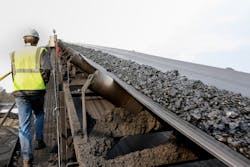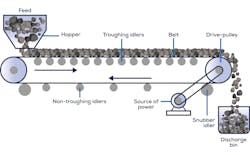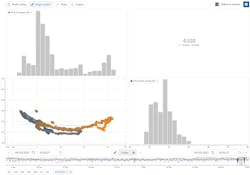Performance-based maintenance achieves energy efficiency goals
Companies engaged in the metals and mining industry are facing challenges that they have never experienced before. While ongoing global economic issues continue to raise the price of oil and gas needed to operate mining equipment, mining engineers must work within a smaller profit margin. Even coal mining operators are tasked with finding ways to meet increasingly stringent environmental regulations related to their operations. As these regulations and public awareness strengthen, engineers are searching for new ways to satisfy the demands and keep their companies profitable.
Industrial companies, including those in the metals and mining sector, are heavy consumers of carbon-based energy. According to the U.S. Energy Information Administration, industrial energy use accounted for 35% of total U.S. end-use energy consumption and 33% of total U.S. energy consumption. Within the industrial sector, manufacturing consumes the most energy at 81%. Mining is second at 9%, while construction comes in at 6% and agriculture at 3%
Mining operators, therefore, are continuously seeking ways to conserve energy. They include reducing consumption, transitioning to renewable energy sources and using energy management systems. One solution is to optimize the efficiency of energy-intensive processes. Mining operators can search through the data they already collect for insights on energy performance and solutions for improvement.
Understanding energy consumption
There are generally three reasons to implement an energy management program:
- To accelerate decarbonization efforts toward Net Zero emissions, including the use of renewable energy sources.
- To reduce costs to remain competitive.
- To comply with various environmental laws and regulations.
The advent of digitalization and Industry 4.0 has brought new solutions to help metals and mining companies use operational data to gain insights on process behavior, which includes energy consumption. Sensor-generated data provides information on temperatures, vibrations and rate of speed, while contextual data adds insights on maintenance reports or unplanned shutdowns. By leveraging operational data, mining engineers find new ways to increase energy efficiency and achieve sustainability goals.
A challenge to consider is that energy management solutions need to span across departments. Efficiency can only be achieved if everyone can contribute to environmental, social and governance (ESG) goals. This includes engineers who are experts on the processes that need to be optimized.
There are many ways to achieve energy efficiency while allowing operational experts to contribute to ESG initiatives. Examples of energy savings opportunities include reducing energy consumption, improving operational performance and cutting carbon emissions. Therefore, different energy saving activities are available throughout the plant, or in this case, the mine. Exploring operational data can provide insights into which processes are the most energy intensive. Operational experts can use this information as the starting point for an energy management program.
Case in point: Reducing conveyor belt energy usage
In the metals and mining industry, conveyor belts, as shown in Figure 1, have several purposes. They are used to transport material from one process to another during smelting and other production methods, for example. They also are used to bring underground metals and minerals to the surface, or to transport them above surface for cleaning and distribution.
They also are high energy consumers. Over time, they also get dirty and need to be cleaned to maintain ideal levels of performance. This interval can be more frequent with dirtier minerals, such as lignite or bituminous coal. In fact, conveyor belts are the bloodline of an underground coal mining operation. Large steel belts bring coal from miles under the surface to the cleaning plant above.
In one case, the engineers at a coal mining operation wanted to learn more about how their conveyor belt consumes energy. To do this, they needed to determine the conveyor belt throughput and the relationship between energy usage and throughput. Learning that relationship provides the optimal operating point. Once determined, they set up monitors to look for deviations from ideal parameters. When a deviation occurs, they know performance is degrading and it is time to clean the conveyor. Energy usage of the conveyor belt fell by 6% while the average time between maintenance periods increased by 11%.
Using advanced industrial analytics software, engineers created a throughput formula tag based on hopper weight. They then made formula tags for energy used per kilogram of coal transported. After they knew how much energy was being consumed, they were able to determine the relationship between energy consumption and throughput, as shown in Figure 2. This information allowed them to set up an operating zone with monitors that look for specific changes and determine when performance drops.
One challenge they encountered was the need to calculate the immediate throughput of coal, which is complicated. They also had to filter and clean the data to exclude periods when the conveyor belt was intentionally taken offline for maintenance or other reasons.
By leveraging operational data, mining engineers were able to identify the optimal throughput for the conveyor belt. To further optimize energy performance, the hopper control was narrowed. The new operating zone monitor gives a clear indication of when the conveyor belt needs maintenance. Engineers can schedule the maintenance when it is necessary to improve operational efficiency and reduce energy consumption.
Conclusion
Metals and mining operators are faced with many sustainability challenges, including the use of energy-intensive equipment. In the case of conveyor belts, degrading performance interferes with an integral part of the operation. It also leads to greater fossil fuels consumption. By using clues found in operational data and applying advanced industrial analytics, mining operators can learn when this performance drops, find the right time to clean conveyor belts and reduce operating energy costs.
David Merschhoff is a customer success manager at TrendMiner based in Germany. With a background in chemical engineering, David helps TrendMiner’s customers leverage operational data for a more sustainable future with a strong focus on ensuring customer success and maximizing value.
Wouter Daniels helps train and advise TrendMiner customers to get the most out of their stored time-series process data. He also provides custom solutions for companies with more complex cases. Wouter earned his PhD in chemical engineering at the University of Leuven, where he studied data analysis and modeling of biochemical systems to increase bioproduct yields.
TrendMiner
About the Author
David Merschhoff
Customer success manager at TrendMiner
David Merschhoff is a customer success manager at TrendMiner based in Germany. With a background in chemical engineering, David helps TrendMiner’s customers leverage operational data for a more sustainable future with a strong focus on ensuring customer success and maximizing value.
Wouter Daniels
Wouter Daniels helps train and advise TrendMiner customers to get the most out of their stored time-series process data. He also provides custom solutions for companies with more complex cases. Wouter earned his PhD in chemical engineering at the University of Leuven, where he studied data analysis and modeling of biochemical systems to increase bioproduct yields.


